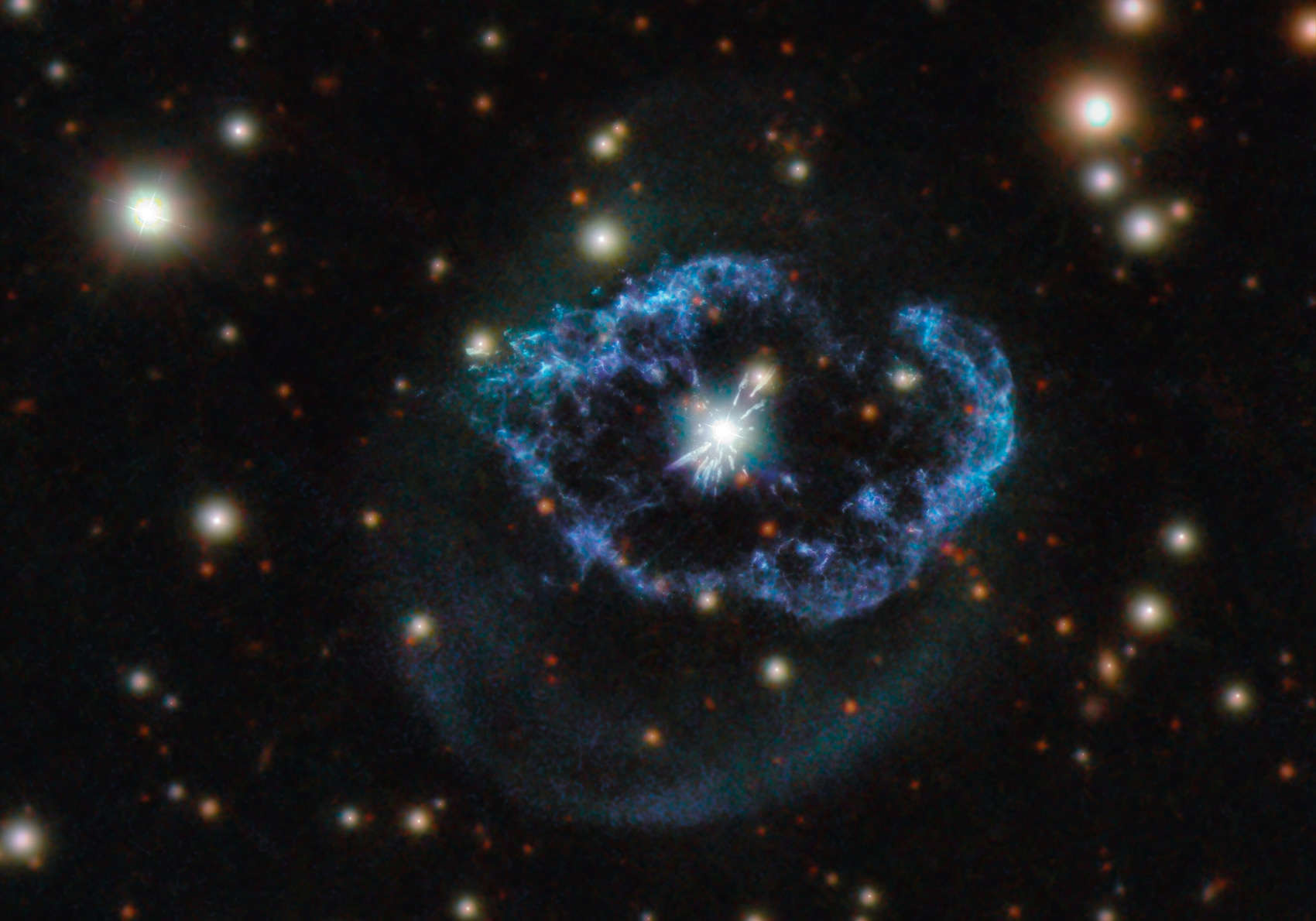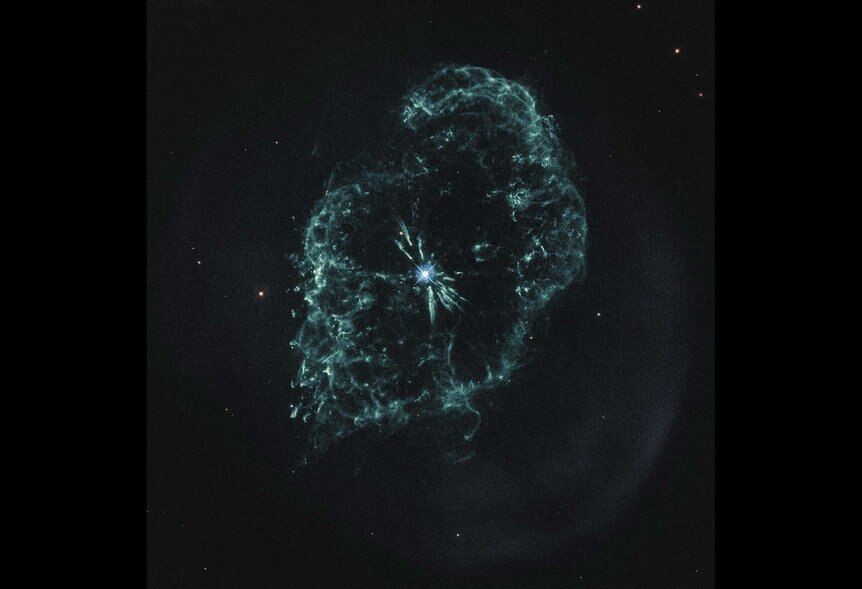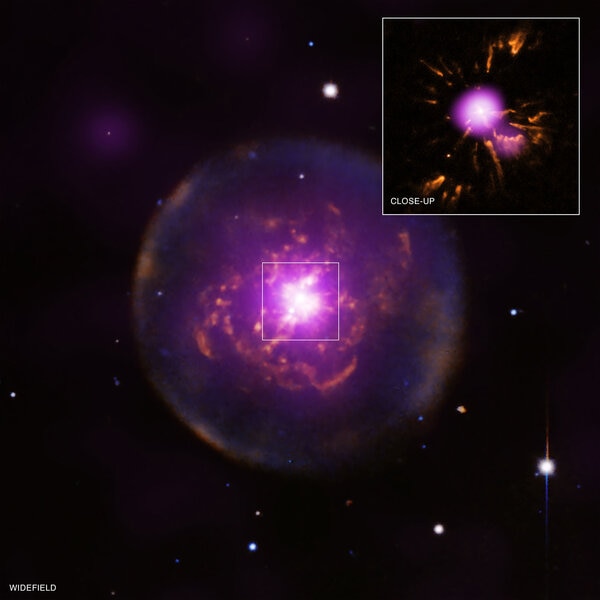Create a free profile to get unlimited access to exclusive videos, sweepstakes, and more!
A star that lived, then died, then lived again, then died for real

Abell 78 is a lovely planetary nebula about 4,500 light years from Earth. Like all of its kind, it was formed when a star similar to the Sun started dying.
It ran out of nuclear fuel in its core, swelled up into a red giant, and started blowing away its gaseous outer layers into a cloud around it. As deeper parts of the star were exposed, a faster wind blew, catching up with and slamming into the older, slower wind. Eventually the core of the star was all that was left: a hot, dense object called a white dwarf, with the mass of a star packed into a ball the size of the Earth.
At this point the fate of the star and gas is sealed. The gas expands away after a few thousand years, and the star cools and fades over the next few billion.
... except that's not quite what happened here.
Near the star, and in the surrounding gas, you can see blobs of gas, some with comet-like tails. A team of astronomers studying Abell 78 looked at Hubble images of it taken in 1994 and 1995, and compared them to more recent ones taken in 2012. What they found is that these blobs had moved visibly in the time between exposures, showing the expansion of the gas. The velocities were typically hundreds of kilometers per second.
The nebula is about 4,500 light years away, which means the actual distance the knots of gas traveled could be found. Coupled with the velocity, that meant they could trace them backwards to the star to find out how long they'd been traveling.
The answer? About 600–1,000 years ago! It appears they came from a single energetic event, some sort of blast erupting from the star very late in its evolution that accelerated the blobs outward.
That's unusual. The timing means the event occurred while the star was well on its way to becoming a white dwarf, when eruptions like that are fairly rare. So how did this happen?
Usually the star's core at this point is made of hugely compressed carbon and oxygen with just a thin layer of helium over it. Sometimes, just outside the core, there's a layer of hydrogen from the old star as well. Or, sometimes the star has a binary companion, another star orbiting it. If the second star orbited closely enough, the first star might have literally engulfed it when it became a red giant, causing the second star to drop even closer due to drag. If it got close enough, the core of the first star could draw hydrogen off of it. As that hydrogen piled up, it would slowly fuse into helium.
That's what could have set the first star off. When enough helium piled up the pressure got high enough that it fused all at once in a huge flash, called a very late thermal pulse. The helium would fuse into carbon which was blasted away in the very energetic event. As it expanded and cooled it would form tiny particles that we refer to as dust.
As it turns out, Abell 78 has plenty of dust, so that makes sense, and the timing works out too. Not only that, but the blobs are all hydrogen deficient, so we know they didn't come from the original outer layers of the star, which were nearly all hydrogen.
So it looks like it was becoming a white dwarf, but then something caused it to erupt, giving it a brief rebirth.
Very brief, really. That phase would happen pretty rapidly, and then the star would once again be headed on the white dwarf track. That's where it is now, a millennium or less after the pulse.
A handful of objects like this are known. Abell 30 is another, as well as Sakurai's Object and Abell 58. It's thought that as many as a quarter of all stars up to about 8 times the mass of the Sun undergo a period like this, but it's so short we rarely see it. As I mentioned it may also be that a close companion is necessary, which is why we don't see many.
Looking at the image of Abell 78, that ring of material makes me think a companion was involved; it's a common feature with binary stars where one star starts to die. The orbiting of the two around each other makes it easier to fling off gas in the plane of that orbit due to centrifugal force, creating a ring (if we see it an angle the circular ring may look like an ellipse). The ring appears to align with the gas outside it, too, giving more credence to this idea.
I studied planetary nebula for many years during and after I got my degree, and they still fascinate me. I love the science behind them, the insight we get into dying stars, the interactions between stars, and the way the gas behaves… but also they're just so darn pretty. I never tire of seeing them.

















